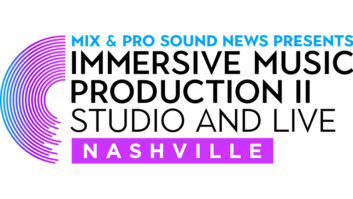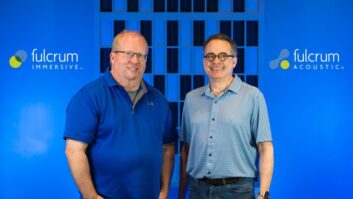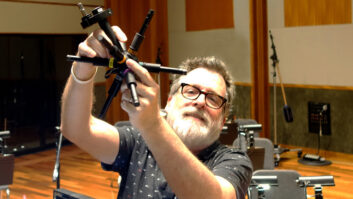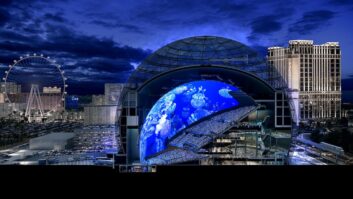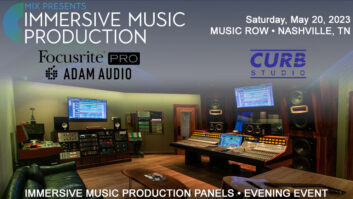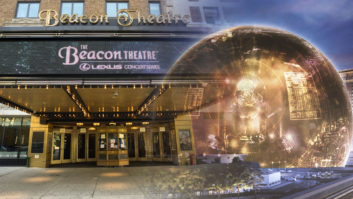
Berkeley, CA—In the current gold rush to remix music for immersive audio release, there is one thing missing, according to mastering and mix engineer Michael Romanowski: Recent recordings. “Very few people are doing anything new that isn’t some quickly remixed legacy rock record,” he comments.
Helping to redress the imbalance between current and catalog immersive audio releases, Romanowski and engineer Eric “ET” Thorngren have mixed a Dolby Atmos version of the Kenny Wayne Shepherd Band’s The Traveler, the stereo version of which debuted at number one on Billboard’s blues and Americana/folk charts in June. Romanowski recently upgraded a room at his Coast Mastering in Berkeley, CA, from 7.1 to 7.1.4 to handle immersive audio projects, adding four Neumann overhead speakers to his existing Focal floor speakers and Meyer sub. A new mastering and mixing room configured for 9.1.6 monitoring will be opening soon at Coast, he adds.
Thorngren, who mixed the stereo version of The Traveler, has worked on six albums and a documentary, 10 Days Out: Blues from the Backroads, with Shepherd since 2003. To prepare for the Dolby Atmos mix sessions at Coast, he says, “I bounced the effects, the reverbs and sounds I had on the instruments, so we didn’t have to go through all the EQing again. Plus, I wasn’t sure if Michael had all the plug-ins that I used. Both Michael and I really like Universal Audio plug-ins. We used their reverbs and effects.”
Related: Getting Immersive with Lady Gaga in Las Vegas, Sep. 3, 2019
The default perspective for many surround mixes accompanying video is from the audience, with the band in front and the venue behind, says Thorngren, who previously mixed all of Talking Heads’ albums in 5.1 with that band’s Jerry Harrison, including the Stop Making Sense concert film’s DVD soundtrack. “But when you do something in the studio, you have to get away from the normal way you see the band and be like you’re in it. When a group is rehearsing, you all look at each other, with your amps facing in so you can hear everybody. Then you think, Kenny’s going to run all over the stage, so we’re going to follow him with the pan; that’s how to do the solos. And maybe bring the background vocals out a bit into the room,” says Thorngren. “That was the way we thought about the Atmos mix.”
“We chose corners for where the instruments would be and, throughout the record, left most of them like that,” says Romanowski. For example, he says, 99 percent of the time, the horns are in the height in the rear. “One of the guitars is on the front left and the second guitar or the Wurlitzer is on the front right side. Drums are in front of you and background vocals are overhead.”
As with 5.1 releases, uncertainty about where a listener has positioned the center speaker, not to mention its frequency handling, is an issue with immersive. “You also have to be careful because this is being brought into binaural,” says Romanowski, for playback over headphones. “If you mess with the center image to accommodate for the center speaker issue, then you can throw the binaural off. It’s a delicate balance to make sure that everything translates across all potential playback systems.”
Nuendo, Romanowski’s DAW of choice, offers easy down-mix monitoring, he says. “And I’m using an SPL console that I helped develop that allows me to monitor or solo different channels. Those were both really helpful in this process.”
Noting that artists and the production team have not always been present for surround remixes in the past, Romanowski says, “That was one of the exciting parts about doing this record. The artist and the management company are involved. The label’s happy. And ET was awesome to work with. It was really fun to do. I put it on for pleasurable listening.”
One challenge is that artists and management may have no frame of reference for immersive audio, he continues. “You can tell them about it all day long, but it’s hard to get people excited about something they can’t hear. Kenny came and spent three days with us and went off on tour. Then he came back and spent a day listening and approving the mixes—because we could send him binaural mixes, but it’s not the same thing.”
As for mastering the immersive project, says Romanowski, it’s all about translatability, as with any playback format. “You want it to sound as even as it can on as many different playback systems as possible, because you can never predict how it’s going to be played,” he says.
Related: NYC’s ArTecHouse Gets Immersive Underground, by Clive Young, Oct. 23, 2019
“The mastering aspect of Atmos is a whole other side conversation about how we, as mastering engineers, prepare to handle this stuff,” he also comments. “What happens if you’re going to do any dynamics processing to the master? Or EQ—how do you make sure you keep phase coherence?”
That aside, as with any project on which he works, “I feel strongly the mix engineer should never be the mastering engineer. I’m breaking my own rules, but I had ET with me,” he laughs. “Because when you’re thinking about balance and how instruments work and fit together, you’re on a micro level. On a mastering level, you don’t care what the content is, you’re thinking about how it presents itself.”
In assembling the songs for the album, he continues, “There was still a little bit of work to be done, such as what are the song-to-song levels? Then there are subtle differences, so there was some EQing to be done on the final mixes to ensure that it became a body of work, not just a collection of songs—and that’s before all the technical stuff for the deliverables.”
Related: Blackbird Studio Takes Immersive to the Next Level, by Steve Harvey, Aug. 28, 2019
Immersive’s future looks bright, Romanowski believes. “Artists can take their creativity and not be bound by a single plane; there’s now this hemisphere. You can put instruments in different places, and you don’t have to over-compress.”
As for consumers, “I just remember the time when everybody said that nobody is ever going to put height speakers in their house. But now, all of sudden, people are going, ‘That’s pretty cool.’”
Coast Mastering • www.coastmastering.com « Facebook: @coastmastering « Twitter: @coastmastering
Kenny Wayne Shepherd Band • www.kennywayneshepherd.net


